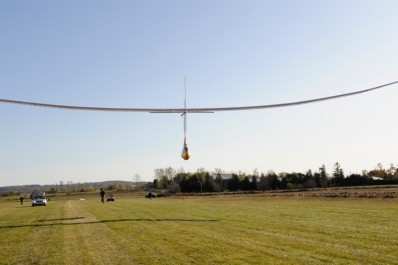First Sustained Flight Of A Human-Powered Aircraft With
Flapping Wings
Aviation history was made when the University of Toronto’s
human-powered aircraft with flapping wings became the first of its
kind to fly continuously. The “Snowbird” performed its
record-breaking flight on August 2 at the Great Lakes Gliding Club
in Tottenham, Ont., witnessed by the vice-president (Canada) of the
Fédération Aéronautique Internationale (FAI),
the world-governing body for air sports and aeronautical world
records. The official record claim was filed this month, and the
FAI is expected to confirm the ornithopter’s world record at
its meeting in October.

For centuries engineers have attempted such a feat, ever since
Leonardo da Vinci sketched the first human-powered ornithopter in
1485.
But under the power and piloting of Todd Reichert, an
Engineering PhD candidate at the University of Toronto Institute
for Aerospace Studies (UTIAS), the wing-flapping device sustained
both altitude and airspeed for 19.3 seconds, and covered a distance
of 145 metres at an average speed of 25.6 kilometres per hour.
“The Snowbird represents the completion of an age-old
aeronautical dream,” says lead developer and project manager
Reichert. “Throughout history, countless men and women have
dreamt of flying like a bird under their own power, and hundreds,
if not thousands have attempted to achieve it. This represents one
of the last of the aviation firsts.”

The Snowbird weighs just 94 lbs. and has a wing span of 32
metres (105 feet). Although its wingspan is comparable to that of a
Boeing 737, the Snowbird weighs less than all of the pillows on
board. Pilot Reichert lost 18 lbs. of body weight this past summer
to facilitate flying the aircraft.
With sustainability in mind, Aerospace Engineering graduate
students of UTIAS learned to design and build lightweight and
efficient structures. The research also promoted “the use of
the human body and spirit,” says Reichert.
“The use of human power, when walking or cycling, is an
efficient, reliable, healthy and sustainable form of
transportation. Though the aircraft is not a practical method of
transport, it is also meant to act as an inspiration to others to
use the strength of their body and the creativity of their mind to
follow their dreams.”

The Snowbird development team is comprised of two University of
Toronto Engineering graduate students: Reichert, and Cameron
Robertson (MASc 2009) as the chief structural engineer; UTIAS
Professor Emeritus James D. DeLaurier as faculty advisor; and
community volunteers Robert and Carson Dueck. More than 20 students
from the University of Toronto and up to 10 exchange students from
Poitiers University, France, and Delft Technical University,
Netherlands, also participated in the project.
“This achievement is the direct result of Todd
Reichert’s dedication, perseverance, and ability and adds to
the already considerable legacy of Jim DeLaurier, UTIAS’s
great ornithopter pioneer,” said Professor David Zingg,
Director of UTIAS. “It also reflects well on the rigorous
education Todd received at the University of Toronto. We’re
very proud of Todd and the entire team for this outstanding
achievement in aviation history.”
 ANN's Daily Aero-Term (04.25.24): Airport Rotating Beacon
ANN's Daily Aero-Term (04.25.24): Airport Rotating Beacon ANN's Daily Aero-Linx (04.25.24)
ANN's Daily Aero-Linx (04.25.24) Klyde Morris (04.22.24)
Klyde Morris (04.22.24) Airborne 04.24.24: INTEGRAL E, Elixir USA, M700 RVSM
Airborne 04.24.24: INTEGRAL E, Elixir USA, M700 RVSM Airborne 04.22.24: Rotor X Worsens, Airport Fees 4 FNB?, USMC Drone Pilot
Airborne 04.22.24: Rotor X Worsens, Airport Fees 4 FNB?, USMC Drone Pilot





